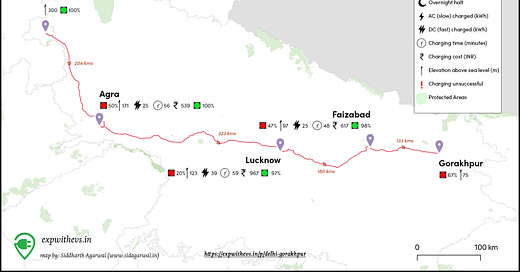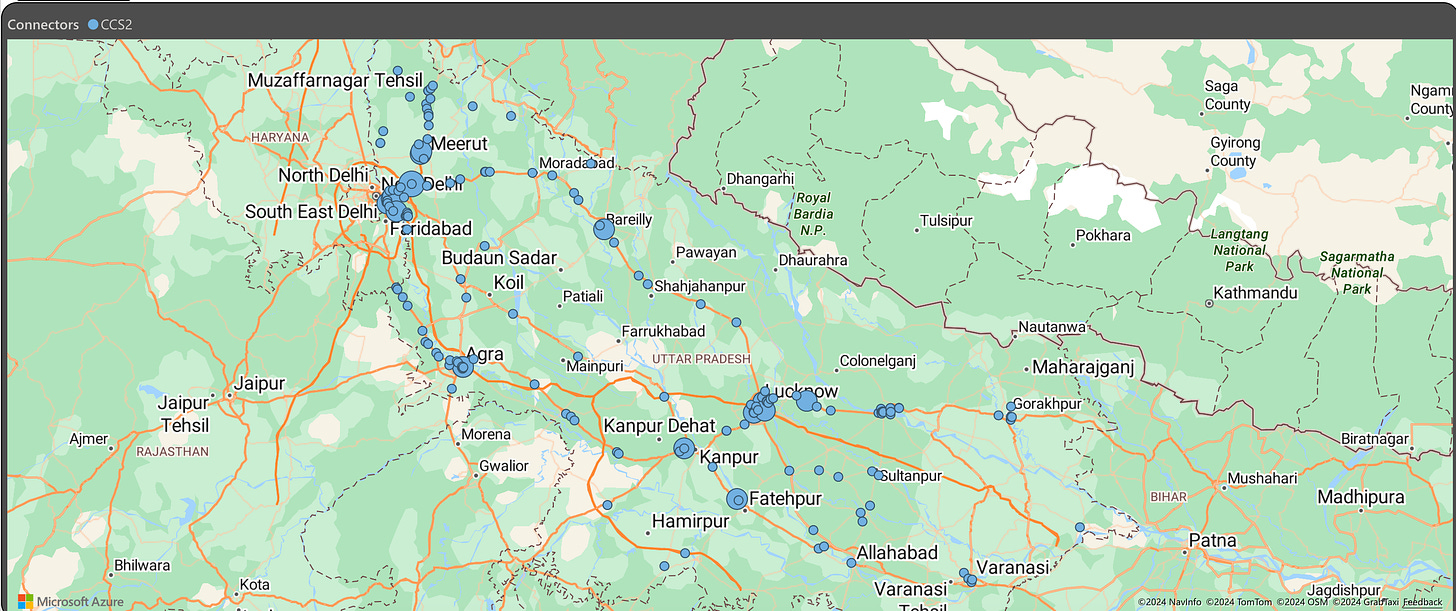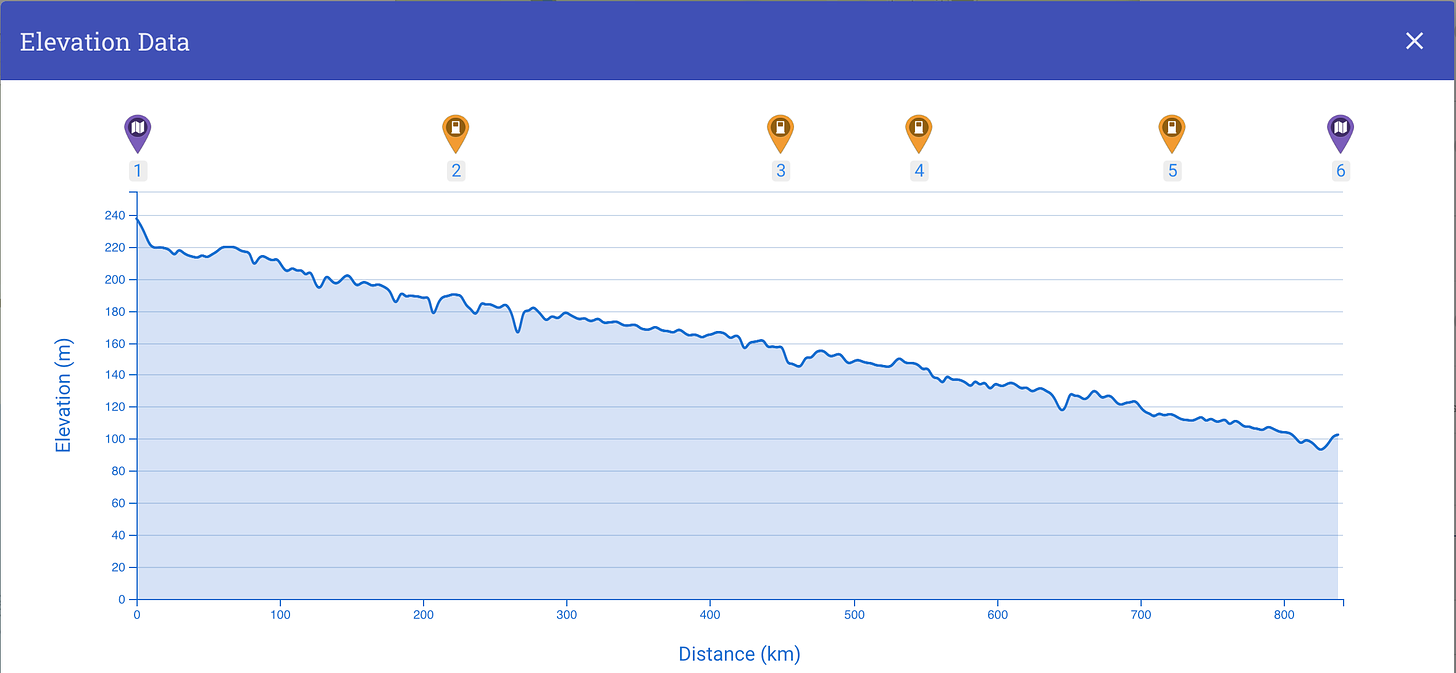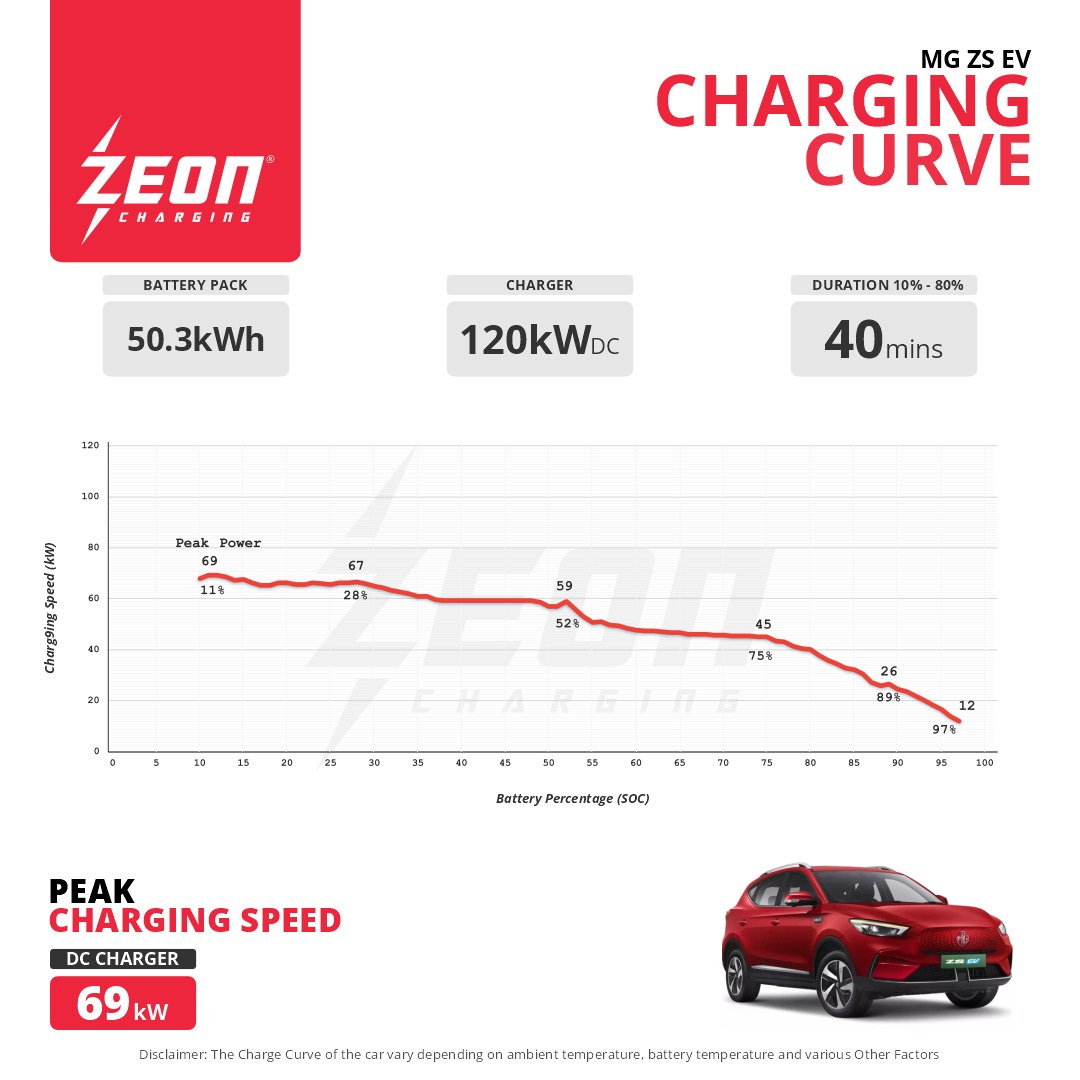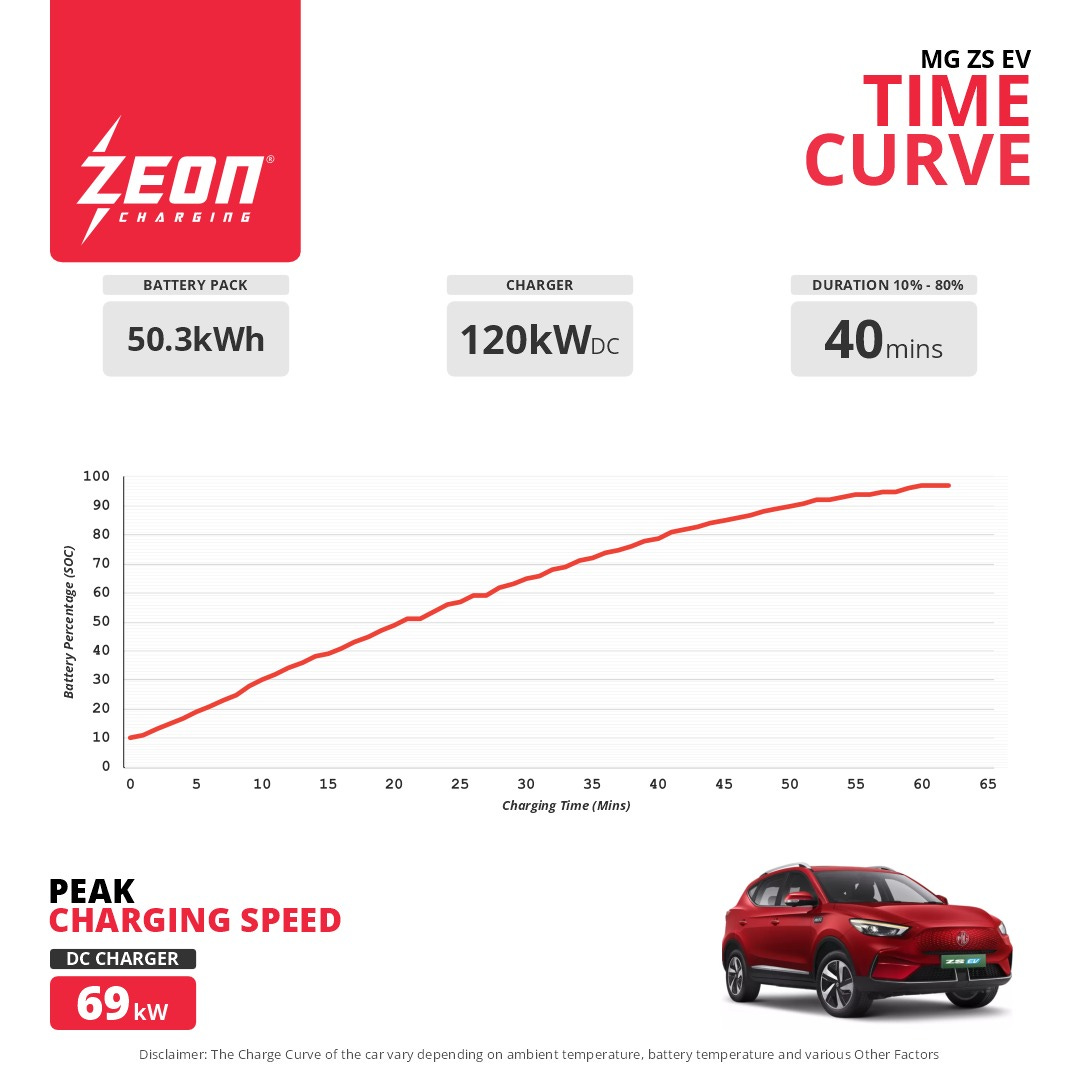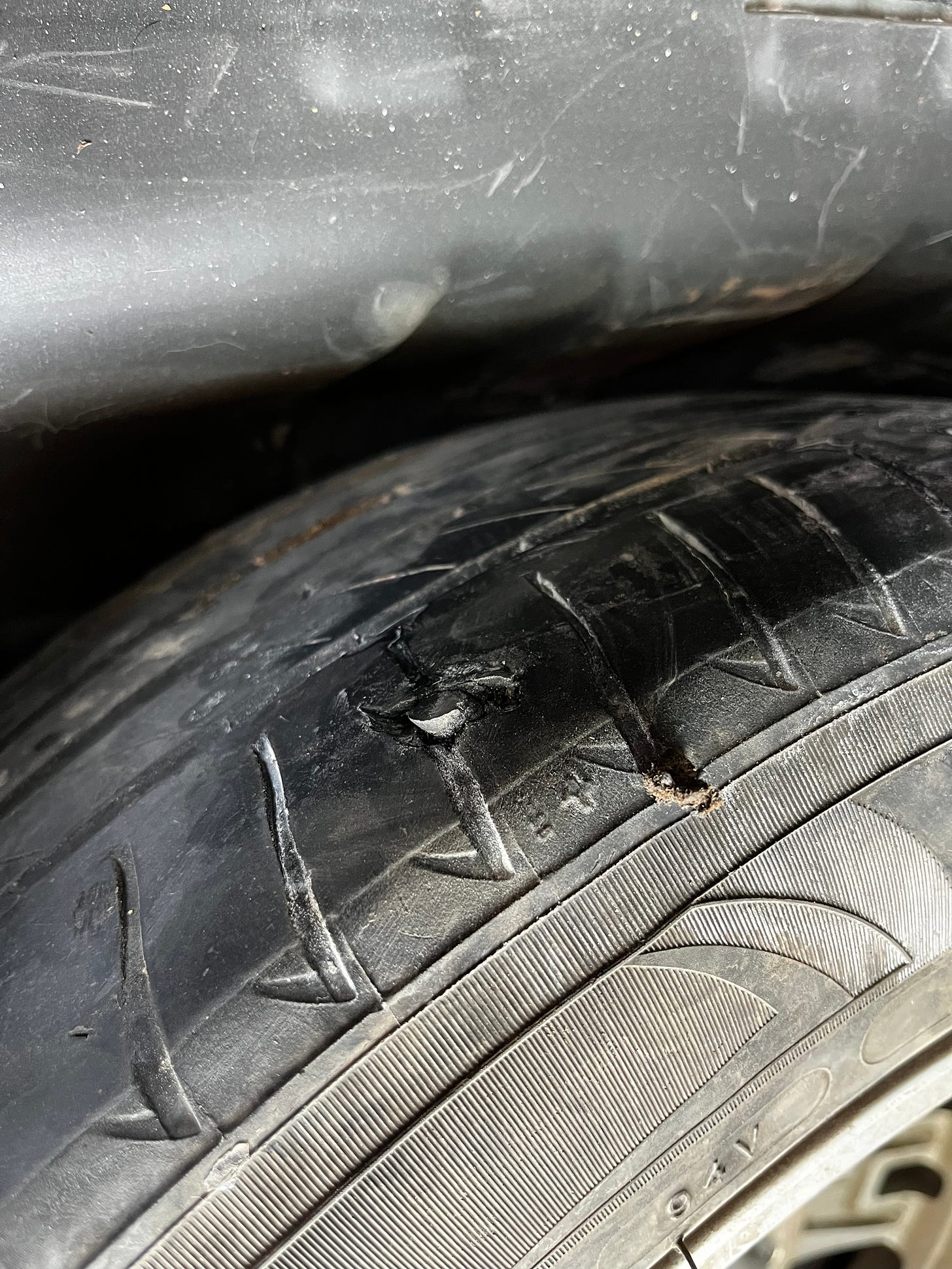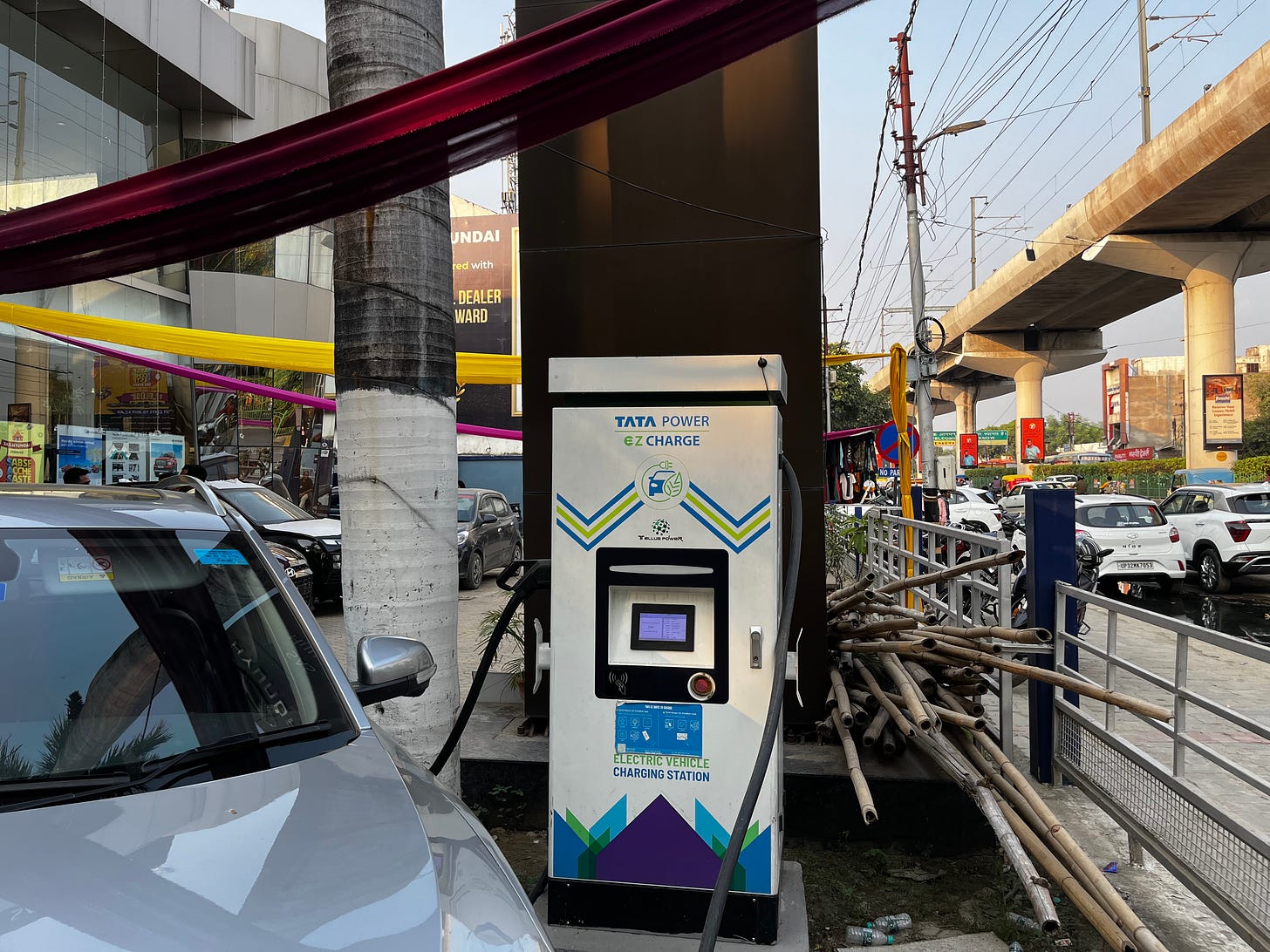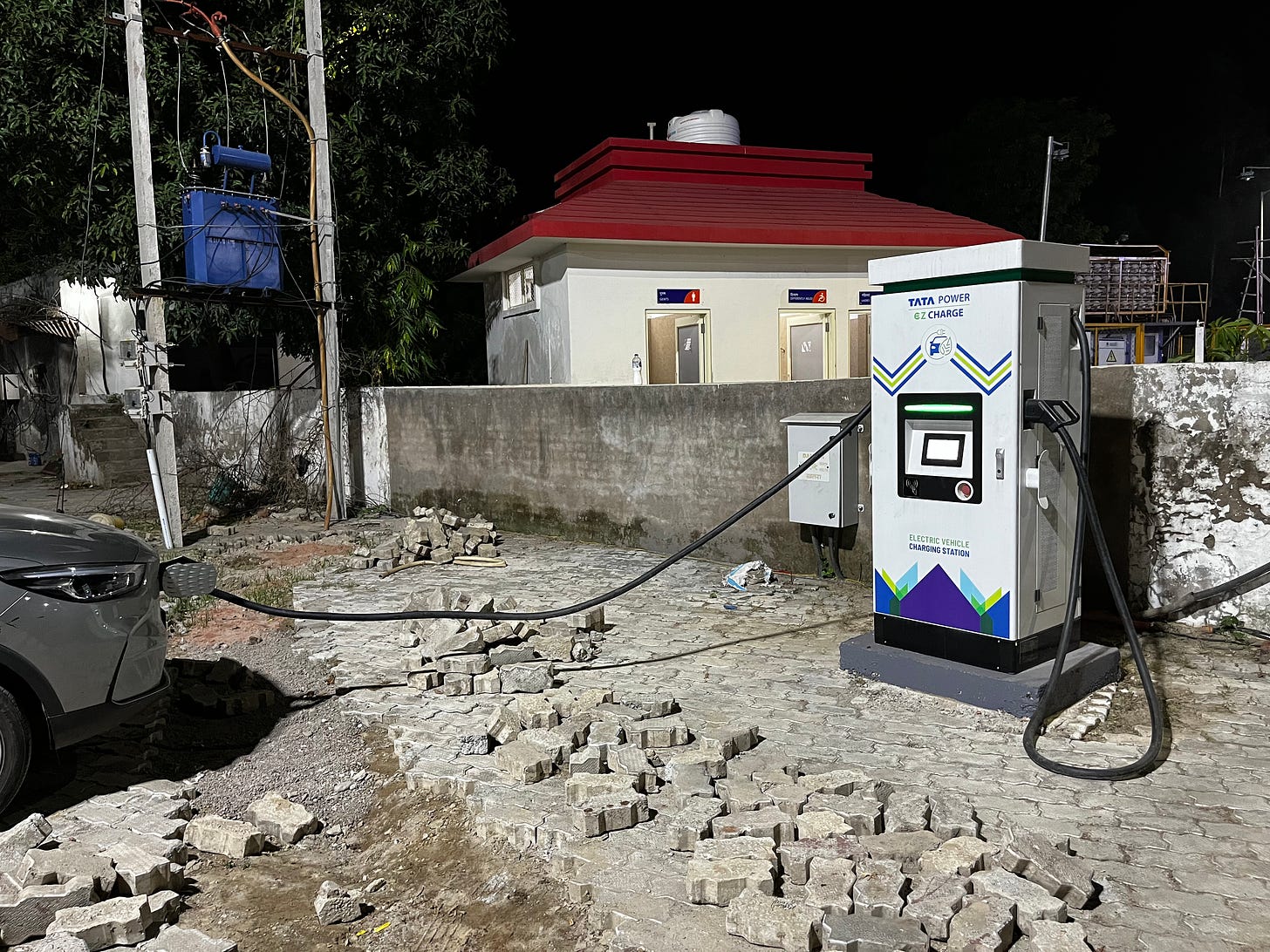New Delhi to Gorakhpur via modern expressways
Is it a two stopper or a three? Also, tire punctures on the expressway.
This article covers the forward journey from New Delhi to Gorakhpur. It talks about charging infrastructure on this route, the planning on how to drive in an electric car and how I selected the charging stations.
Housekeeping
Here’s a quick catchup of what has been happening so far.
ExpWithEVs has gone paid. Industry articles are now behind the paywall. You should subscribe if you are from the industry or if you have deep interest. Paid subscribers get priority access to the ExpWithEVs team.
You can also refer this newsletter to others to earn free paid subscriptions.
I released an industry-first charger intelligence tool called EVInfra.BI. If you haven’t bought a license yet, I would recommend to lock it in at a cheap rate now!
I am collecting the brochures of all charger hardware manufacturers and assemblers. Please send me the brochures for your products at priyans@expwithevs.in.
If you’ve been following me on X, I live tweeted this trip and my Delhi - Mumbai trip. Check it out.
I am still looking for an editor to make a short video about my Kolkata to Mumbai trip. It is a paid opportunity and you can reach out to me at priyans@expwithevs.in.
In October, I wrote about what we can expect from Maruti, going deep into the technical details along with estimated charging speed etc. Much of it is in sync with what was released on November 4th.
My consumer case with Tata Motors is progressing well. Subscribe to be the first ones to know what’s happening.
As usual, if you’d like to skip the text, you can dive into the data for the Delhi Gorakhpur trip here.
Check out my pan India charging stations playlist on YouTube. Enjoy!
The Planning
I was travelling from the North West end of Uttar Pradesh to far east Uttar Pradesh.
This road trip presented me with two options. I could take the newly built expressways (Yamuna Expressway, Agra - Lucknow expressway) or take the old Grand Trunk Road. I had taken GT Road during my trip from New Delhi to Kolkata. Read more about that trip here.
The biggest issues with the new expressways are unavailability of working chargers and a slightly longer route than the GT road. The trip is 830 km via the expressways and 770 km by GT Road.
The thick orange lines are new expressways built from New Delhi to Agra, Agra to Lucknow and Lucknow onwards to the eastern end of UP.
The thinner orange lines are old highways. The charger density is sparse on the thicker orange lines as compared to the thinner orange lines.
Key factors to keep in mind :
Delhi - Agra expressway - also known as Yamuna Expressway - 165 km
Agra - Lucknow expressway - 302 km
Lucknow - Gorakhpur - 289 km.
The elevation profile across Uttar Pradesh is similar, causing minimal impact in the charging plans.
Let’s go!
Delhi - Agra
With a nifty charging stop, it is possible to go from New Delhi to Lucknow in a 2022 MG ZS EV. Lucknow is ~475 km from South Delhi whereas my MG has a real world range of ~400 km. The charging stop in question here is at Gujepur. There’s a Jio BP charger hosted on the Agra - Lucknow expressway. It is a solitary 60kW charger that has an 11kW sanctioned load. The experience to charge here is pretty poor, hence I had to change plans.
As of October 2024, there aren’t working chargers either on Yamuna Expressway or the Agra - Lucknow expressway.
Yamuna Expressway is shorter, only 165 km. The Agra - Lucknow expressway is slightly over 300 km. Agra to Lucknow can be covered with a full charge if the AC is on, or with approximately 85% charge with no air conditioning. Cars charge dramatically slower when the state of charge is higher. This results in a longer charging stop at Agra, right at the beginning of your journey.
I’ve driven to Lucknow once earlier via the Yamuna Expressway (Delhi - Agra) and the Agra - Lucknow Expressway. I had charged at ChargeZone’s charger at Courtyard by Marriott in Agra then. You can refer to all the data from that trip here.
This time I wanted to change things up a bit. There’s not much to do at the Courtyard property and I wanted to try some street food. So, I looked at other charging options. My criteria were - 60kW and above, as close to the Yamuna Expressway as possible, clean washrooms and some roadside stalls to eat fresh food. Statiq’s charger at ITC Mughal fit the bill. It was slightly inside the city as compared to the Marriott charger, but still easy enough to get out of the city without getting stuck in a traffic jam.
Free tip to CPOs reading this - please look for 60kW and above charging options near Saifai / Karhal in Uttar Pradesh. It is roughly 300 kilometres from New Delhi. It will massively help customers travelling from New Delhi to Lucknow or elsewhere in Uttar Pradesh. The expressway charging infrastructure is often a tedious bidding process and we know how deeply the bureaucracy loves the L1 players. If you are a paid subscriber, then do let me know if you’d like a technological breakdown of any open tenders. Drop an email to priyans@expwithevs.in
I started from New Delhi with a 100% charge at around 5:30 AM. The displayed range on my car is 394 km, whereas previously it was 400 km on a full charge. There’s a major concern about an EV’s battery degradation over the years. I’ve been collecting some data about it and will soon publish an article. Please subscribe, if you haven’t already to not miss out!
The first segment of the drive is often great fun. There’s excitement about the journey. The weather is perfect with the nip in the air and fresh winds blowing through the fields next to the expressway.
Two hundred kilometers and three and a half hours later, I reached ITC Mughal, Agra. There was an adwall charger by Statiq, which is a massive screen (to show ads) with a 7.2 kW Type2 charger. I don’t know who thought that someone would look at ads on the chargers while slow charging their car which can often take hours. Anyway, good on them to atleast try something.
On my return trip from Gorakhpur, I stopped at ITC Mughal again and learnt that the charger is run on a diesel generator when it cannot pull the desired load from the grid. It wasn’t surprising because a hotel like ITC would have a diesel generator. I would not have chosen this place if I knew this. The charger hardware says 120kW but I could charge at a maximum speed of 50kW during both times. Their app claims that you can get upto 120kW on each of the dual guns.
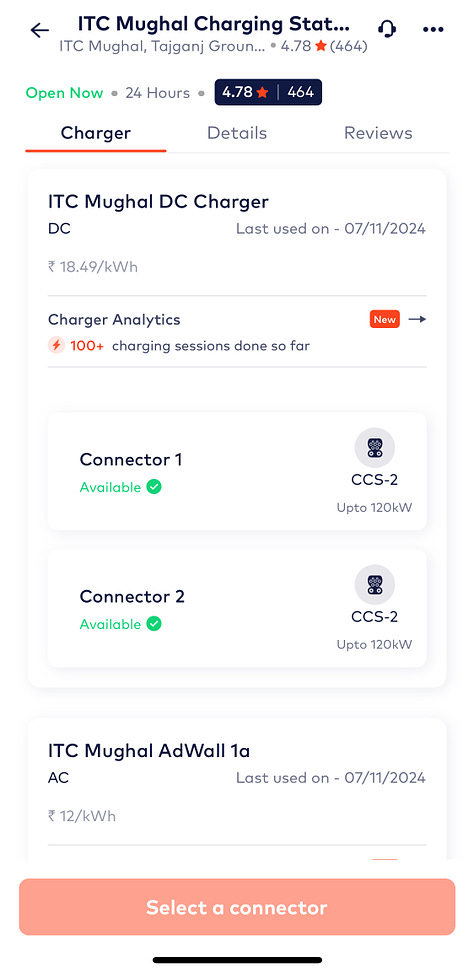
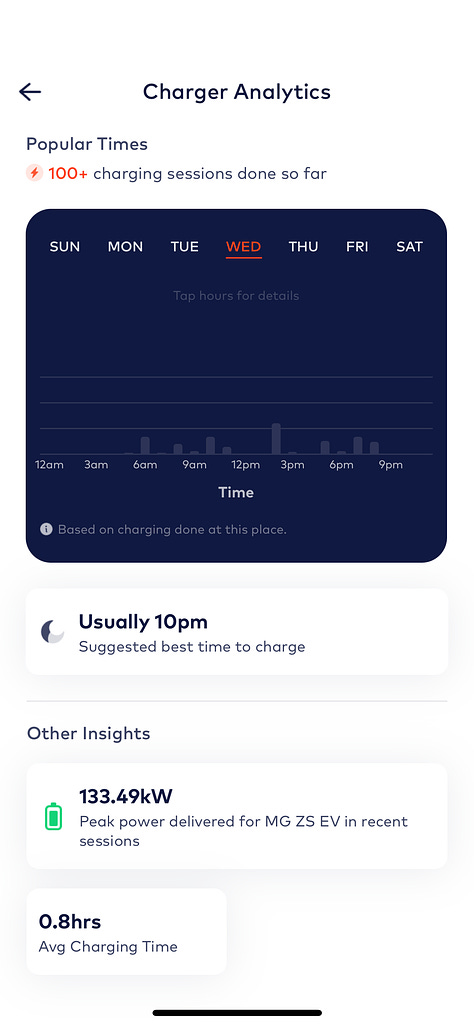

The time taken to charge (forward journey) from 50% to 100% is the same as the time taken to charge on my return journey from 9% to 92%. During the first instance 25kWh was added to the pack. 42kWh was added in the return journey.
I would also like to highlight Zeon’s efforts to make data public on the charging speeds. Please refer to the screenshots below to get an idea of how fast a ZS EV can charge.
These charging curves by Zeon Charging look a lot like the experience I had when I was charging here the second time. It took longer in the forward journey. I don’t exactly know why.
A Tata Tiago was slow charging here at one of the Type2 plugs. Check out how it looks.
The charging station didn’t have any benches to sit under the trees or dustbins nearby to throw garbage.
Agra - Lucknow
My car has traveleved over 60,000 kilometers in the past couple of years. There’s some wear and tear on the tires and I’ve had a few punctures. Before leaving for this trip, I got all the five tires (including the spare) repaired over a period of a month from various repair shops across New Delhi.
Despite all the fixes, one of the tires failed on this trip. I got it checked at a petrol pump on the Yamuna Expressway. They filled the air and asked me to observe while driving. The front left tire was almost flat by the time I got to Agra and started charging the car. After the charging session at ITC Mughal, I got it checked by another tire repair guy in Agra.
Coincidentally, the tire repair shop was next to a Nuego bus charging station. The charging station had multiple 180kW chargers, with two connectors being attached to charge a bus in a single go. More insights on these will be available for paid subscribers.
The repair guy replaced the tire with the spare one. He said that this puncture cannot be repaired here and it is better to replace it. The spare tire was put on, air filled, and I started driving again.
I got on to the Agra - Lucknow Expressway. The tire pressure started dropping slowly and I knew the inevitable was near. I scrambled to search for a tire repair shop on Google Maps on my route to Lucknow.
To my delight, there was a petrol pump with a rest area almost hundred kilometers in, on the Agra Lucknow Expressway. There was bound to be someone there who could help. The other options were only at the end of this expressway. By the time I got to the rest stop, the tire pressure was between 25-30 PSI whereas it was 40 PSI when full.
At the petrol pump, I was asked to go behind the food plaza and ask the repair guys there to help. Their regular clientele consisted of a lot of trucks as there were a lot of trucks around in various stages of being repaired. If truckers can trust these guys, then they ought to be solid. They inspected the tire and concluded that there is no visible puncture. When the tire is stationary there’s no air leakage, but when it is moving, one of the punctures tear up and start leaking the air.
They suggested putting a tube in the tubeless tire. I agreed. In 20 minutes, a new tube was put in. The TPMS (Tire pressure monitoring system) had to be sacrificed in this process. Nervously, I drove a test lap and it seemed fine. I soldiered back on the expressway after picking up a large coffee.
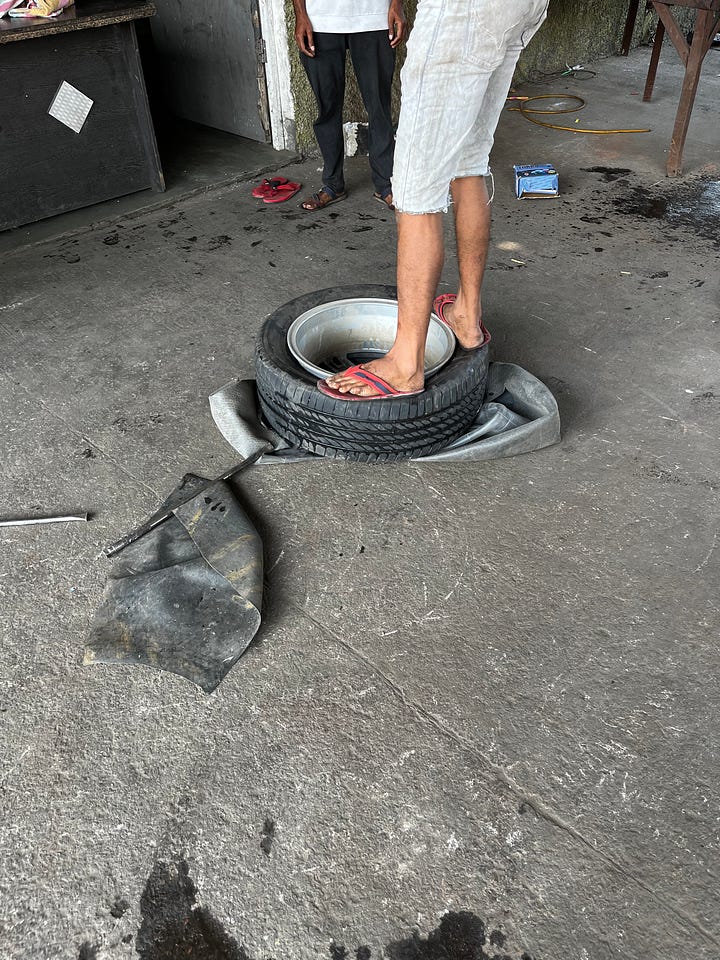
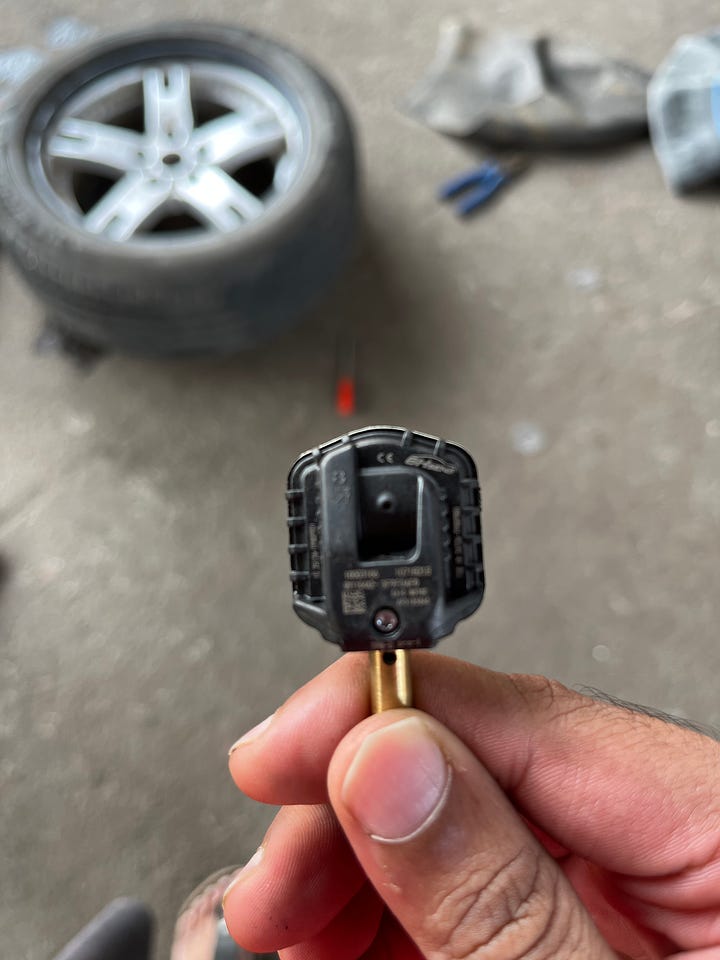
There was a solitary non working Tata Power charger, not mentioned on the Tata PEZC app. It looked pretty old. Chargers on Expressways are crucial and I don’t know why these guys don’t get them working. If you know why, drop a comment.
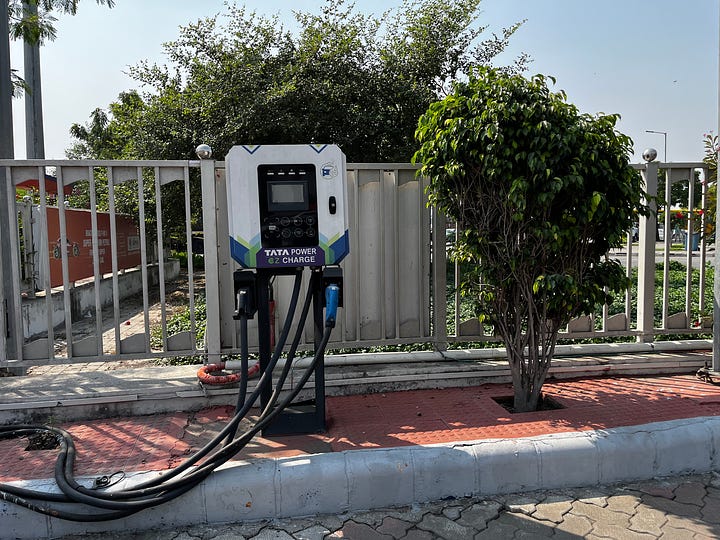
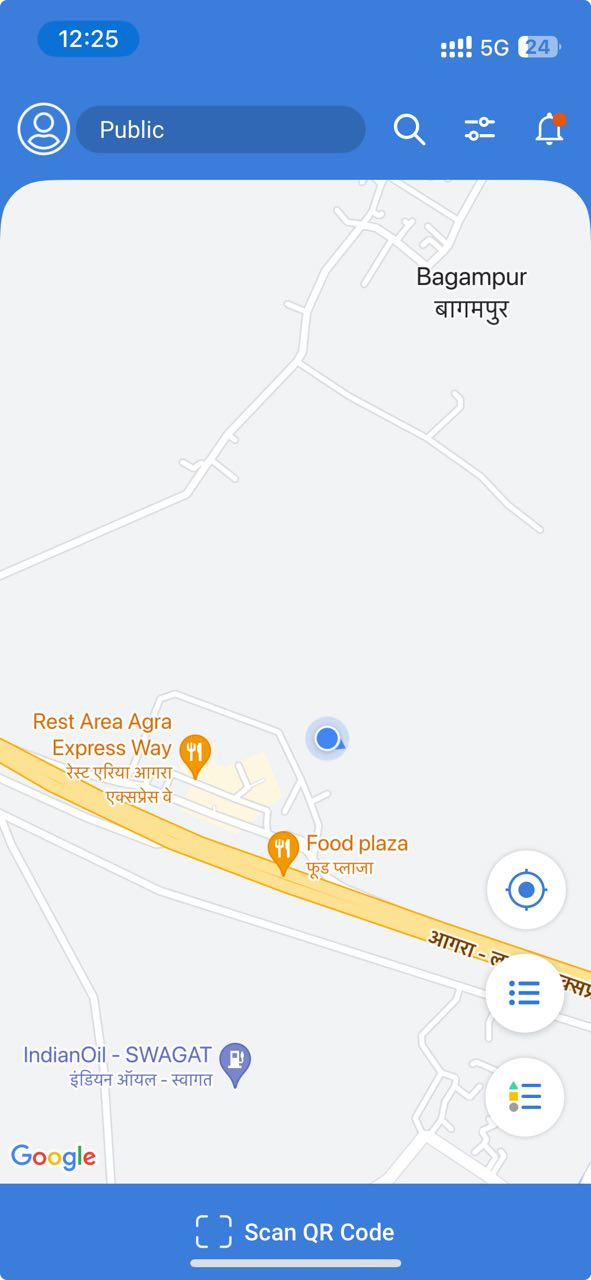
Last time in Lucknow, I charged at Lulu Mall after _7567Rex’s recommendation on X. This analysis from last time still holds true.
In Lucknow, I preferred to not enter the city and choose the charger closest to the highway. That left me with few options - SAS Hyundai Tata Power (60kW), Lucknow Airport Adani (30kW), IT Tribunal Labotek EV (30kW) and Lulu Mall GOEC (60kW). The first one was a dealership. The second one could have issues accessing the charger because it could either be airside or landside. I had never heard of Labotek CPO and it wasn’t confidence inspiring. Lulu Mall on the other hand had 1 25kW, 1 60kW and 1 7.2kW chargers. Plus with a mall, you are guaranteed to get food.
There are a few newer options in Lucknow to charge provided by Statiq, Tata PEZC and Glida. But most of them are in the city.
I stopped at GOEC’s Lulu Mall charger on my way back. While heading to Gorakhpur, I had to pick up some relatives from the Lucknow airport. I had timed the drive in a way that I am 100% charged by the time their flight landed at Lucknow.
The tire debacle and slower charging speed in Agra meant that I would be an hour late if I charged on a 60kW charger, two hours late if I chose the 30kW. Naturally, SAS Hyundai was the best bet. I failed multiple times to prebook the charger on the Tata PEZC app. The process is cumbersome. ChargeZone has a much simpler way to book a charging slot. Booking a slot would guarantee access to the charger, incase there were others around. The plan was to not stop anywhere and head straight to Gorakhpur from Lucknow. The distance is around 300 km and I wanted to leave with a 100% charge. It was hot and with AC, the energy consumption could rise pretty quickly.
The dealership had very tight parking space and I was lucky that the charger was empty. Someone had just finished charging and had left. I thanked my stars and plugged in my car at 20%. The tailwind on the way to Lucknow helped with the high efficiency.
With tail wind, the car consumes less energy to cut through the wind. So, the next time you are planning a trip, do not forget to check the wind speed. It has an impact on your consumption numbers.
The dealership had a clean washroom and multiple places to drink water. It was a showroom cum service center, so there was a decent amount of cars shuttling in and out. There was also a place to wait in the showroom while the car was getting charged.
I planned to charge as much as I could because it was possible that the chargers on the Lucknow Gorakhpur highway weren’t working. There were plenty of chargers in Ayodhya, but I didn’t want to enter the city or stray too far from the highway. My relatives recommended a restaurant they like to stop at - Awadhesh Dhaba at Vikramjyot, just after Ayodhya. I immediately checked PlugShare and was so happy to see that there’s a Tata PEZC 60kW recently installed there. When I checked the Tata PEZC app for the live status, it was shown as offline.
Lucknow - Gorakhpur
The charging speed reduces drastically as it approaches 100% charge. It can easily take 15 to 20 minutes to go from 90% SoC to 100% SoC. It can take longer if the battery pack voltages are not balanced. I disconnected the charging at 97% SoC and headed to the airport to pick up the relatives.
Soon enough with the AC on, we were on our way to Gorakhpur. It was already dark by 6-6:30 pm. In three hours, we covered 180 kilometers. The car was just under 50% SoC. We had another two hours to go to cover the rest of the 100 odd kilometers. We decided to take a break at Awadhesh Dhaba in Vikramjyot for dinner. To my surprise, the charger was working again! I didn’t have to necessarily charge, but whenever one has the opportunity, one should charge.
P.S.: The food was pretty tasty and the restaurant seemed to be quite busy.
As Bjorn Nyland says - ABC - Always Be Charging - I plugged in the car at a rather awkward angle.
It took us around 45 minutes to wrap up dinner, which was enough to charge the car from 47% to 97%. In hindsight, it was best that we charged the car fully. I knew I would prefer charging on the portable charger in Gorakhpur. If the charge was pitifully low, I would have made a trip to a nearby Tata Power or an Adani fast charger. But it is always better to have extra charge in the car. My relatives were kind enough to setup a slow charging point near their house with a complete 4 core cable and a grounded 15A socket.
In a couple of days, I headed back to New Delhi. The charging details for the same can be found on this Google sheet.
Summary
The return trip stats are as follows :
Total distance - 1659 km (~1030 miles)
Total cost of charging - INR 3807 (~US$45)
Total kWh consumed - 216 kWh
Toll costs - INR 3245 (~US$38)
This piece can be re-published (CC BY-NC-SA) with a line mentioning ‘This was originally published on ExpWithEVs.in’ and a link back to this page. In case of re-publishing, please alert priyansevs@gmail.com
Text, data and editing - Priyans Murarka
Maps - Siddharth Agarwal

